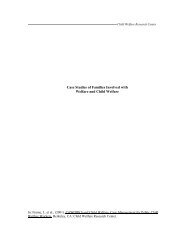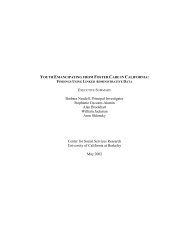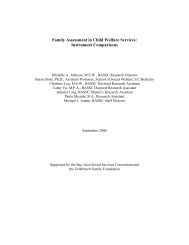Developing a Self-Assessment Toolfor Culturally - Office of Minority ...
Developing a Self-Assessment Toolfor Culturally - Office of Minority ...
Developing a Self-Assessment Toolfor Culturally - Office of Minority ...
You also want an ePaper? Increase the reach of your titles
YUMPU automatically turns print PDFs into web optimized ePapers that Google loves.
Exhibit 2-2CONCEPTUAL FRAMEWORK FOR ASSESSING CLAS IN LPHAsDOMAIN / KEY ELEMENT1. Organizational GovernanceA. Governing boards,committees, and positionsB. Organizational StructureVARIABLESA. Local Board <strong>of</strong> Health subcommittee on CLASPermanent advisory committeeCommittee recruitment strategiesCommittee racial/ethnic compositionCommittee diversity other than race/ethnicityInternal CLAS working groupStaff position specifically for CLAS coordinationFrequency <strong>of</strong> meetingsCommittee’s role in CLASB. Formal grievance procedureClient population size2. CLAS Plans and PoliciesA. CLAS planning A. Formal quality improvement plan for culturally and linguisticallydiverse clientsInternal CLAS planning and working groupsStaff and community inputMission statement addresses CLASCommittee roles related to CLASB. CLAS policies B. CLAS training program reviewTranslation products reviewTargets for translated materialsDescription <strong>of</strong> translationPolicies governing written translationReasons translation policies existsReasons translation policies do not existPolicies governing interpretation servicesReasons interpretation policies existsReasons interpretation policies do not existFormal grievance process for CLAS-related concernsDocumented policy for interpretersFormal staff diversity planFormal diversity training programStaff position for CLAS coordinationStaff and community inputInternal communication strategies for CLAS policies3. <strong>Culturally</strong> Inclusive HealthCare Environment andPracticesA. <strong>Assessment</strong> and TreatmentB. Materials and EnvironmentA. Cultural differences and preferences consideredFamily members and preferences consulted during diagnosis andtreatment<strong>Culturally</strong> specific healers and physicians consultedUtilize alternative and complementary treatmentsB. Cultural differences and preferences consideredFamily members and preferences consulted during diagnosis andtreatment<strong>Culturally</strong> specific healers and physicians consultedVarious culturally responsive strategies implementedCharacteristics <strong>of</strong> written materialsAlternative and complementary treatments available(Continued on next page)COSMOS Corporation, December 2003 2-11
















